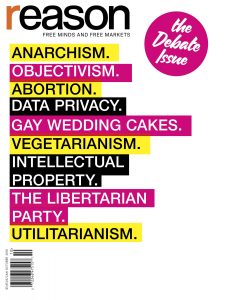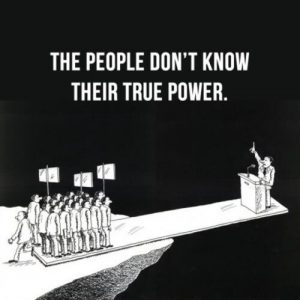[cross-posted at C4SS and BHL]
Reason magazine editors Nick Gillespie and Katherine Mangu-Ward have recently debated the question of minarchism (i.e., minimal government) vs. free-market anarchism.

As an anarchist, I’m obviously on Mangu-Ward’s side of the debate. But both writers make some assumptions about strategy that I find problematic.
I’ll start with Gillespie, who expresses impatience with “boring, tedious, and fundamentally irrelevant discussions about hypotheticals, first principles, and extreme a priori-ism that are light-years removed from anything to do with the world we actually live in.” Gillespie mockingly admonishes us anarchist nerds to drop the philosophising and wake up to pragmatic reality:
Why bother figuring out what school choice programs should look like? Haven’t you heard? TAXATION IS THEFT, and nonvoluntary government institutions are not simply misguided – they’re absolute violations of the [Non-Aggression Principle]. If that’s true, then conversations about policy, much less libertarian approaches to literature, art, community, religion, and everything else humans do on a daily basis, might as well be planting a flower garden in a concentration camp. …
Some things will always be subject to political consensus, but let’s limit those to the few that are absolutely necessary. That isn’t a clear line but a constantly shifting border that will always have to be negotiated. But one clear benefit of small government over anarchy is that it swaps out bull sessions about first principles for a conversation that most of us are already having, which is where and when to draw the boundary of governmental control over us.
But the contrast that Gillespie draws is puzzling. How is one supposed to answer questions about “where and when to draw the boundary of governmental control,” if not by appeal to principles?

Nick Gillespie is too cool to be an anarchist
Gillespie’s answer is that we should seek to “increase the spaces where we get to choose (or invent) how to live,” without necessarily being committed to a description of the ultimate goal. “I know the direction in which I’m walking,” Gillespie writes, “even if I don’t yet know my final destination.”
But that can be true of anarchists too. I don’t think of the abolition of the state as a final destination; I think of it as one step – albeit a crucial step – along the path of combating coercion and domination, a struggle that may never be finally completed.
Just as the struggle for racial equality wasn’t over merely because formal slavery had been abolished by the 13th Amendment, the anarchist’s job won’t be finished just because the state gets abolished. (Though I think taking a week off for a massive party would be appropriate.)

William Lloyd Garrison, radically uncool
All the same, having radical goals in view can be of vital use in moving that “shifting border” to which Gillespie refers. In the words of William Lloyd Garrison, perhaps the most prominent American abolitionist:
Urge immediate abolition as earnestly as we may, it will, alas! be gradual abolition in the end. We have never said that slavery would be overthrown by a single blow; that it ought to be, we shall always contend. (The Liberator, 13 August 1831)
Has not the experience of two centuries shown that gradualism in theory is perpetuity in practice? (The Liberator, 28 December 1838)
Or, as C4SS Senior Fellow Charles Johnson puts it:
[I]f you start out asking for what you actually want, rather than what you think you can get, you’ll often end up getting less than you wanted in the end. But you’ll do a damn sight better than if you start out asking for what you think you can get, and then bargain down from there.
Gillespie, by contrast, sees visions of ultimate success as an obstacle to progress. Gillespie writes:
Duke political scientist Michael Munger makes a useful distinction between what he calls directional libertarians and destinationist libertarians. The latter tend to be anarchists, and their focus is on very specific and absolute outcomes: The only good government is no government. Anything that stops short of that is a mistake. Directional libertarians instead deal in relative terms and ask the question: Given where we are at any moment in time, what policies and mindsets increase the available options for how to live?
Again, this seems like a false dichotomy. Why can’t you have the abolition of the state as a goal, and still favor steps that increase freedom along the way?
The answer, for Gillespie, seems to be that, as he sees it, these incremental steps necessarily involve working within the established political system – something anarchists tend to eschew as involving unacceptable compromises. Gillespie even advocates trying to make common cause with Bernie Sanders and Rick Santorum on various legislative reforms. But is conventional political activism really the most promising venue for incremental progress? Is it better to try to reform the system from within, or to try to subvert it from below?

Sam Konkin bought his glasses illegally
According to agorism, an approach developed by libertarian thinker Samuel E. Konkin III in the 1970s (though one with affinities to the historical anarchist tradition more broadly), a more promising strategy for change than piecemeal legislative reform is the “counter-economic” approach of building alternative institutions to bypass the state and ultimately render it powerless and irrelevant. Agorism in effect gives a free-market spin to such traditional anarchist notions as “dual power,” “prefigurative politics,” and “building a new world in the shell of the old.” In that sense, agorism follows in the tradition of Proudhon, who wrote:
Beneath the governmental machinery, in the shadow of political institutions, out of the sight of statesmen and priests, society is producing its own organism, slowly and silently; and constructing a new order, the expression of its vitality and autonomy.
Recall also Gustav Landauer’s famous formulation: “The state is a condition, a certain relationship between human beings, a mode of behavior; we destroy it by contracting other relationships, by behaving differently toward one another.” And another anarchist, Paul Goodman, has noted: “A free society cannot be the substitution of a ‘new order’ for the old order; it is the extension of spheres of free action until they make up most of social life.”
One of the chief advantages that counter-economics has as a strategy is that there’s very little chance for progress at the margin with traditional party politics, because … well, what do you need to do in order to get an issue passed? You need 50% plus one to vote. … In order for any politician to be able to accomplish much of anything, you need to be able to have this very large backing …. And if you get 30% of the vote … you’re no further along than you were before. … The upshot is that in electoral politics you have to be in a position to win everything before you can win anything. … Whereas with counter-economics, you don’t need majoritarian support, you don’t need political parties …. All that you need is enough capacity to get around the particular forms of government oppression that are affecting you right now ….
Charles Johnson, doing some homesteading
If you look at the way that people actually live their lives, of course people are able to do that all the time. You know, government says drugs are illegal, but people sell and take drugs. Government says that it’s illegal for you to exist in the United States without a signed permission slip from immigration and customs enforcement, but you know, millions of people come in every year in spite of that. And so if you want to figure out “how do we get to a free society from where we are?” – look at what those folks are doing, because the forms of free association that they’re practicing in order to get the things that they want are things that you can start applying in your own life right now; and you can make small changes on the margin to get yourself closer and closer and closer to a free life than where you are now. You don’t need the backing of 50% plus one of the population. And so it allows for small progress along the line. … It provides an actual route to get from where we are now to where you ultimately want to be, which steadily improves all the way.
And so because there’s this chance for incremental progress that there isn’t in party politics, you get this definite strategic advantage … because you don’t have to figure out some grand plan to make a global free society right now. What you start doing is you start improving your life in the process of working together with other people to get the things that you want independently of the state. And it allows you to get to where you want to be, step by step by step.
Defenders of traditional political activism tend to reject counter-economic approaches as impractical and ineffective. In reply, Johnson invites us to compare “the practical success that the immigration reform movement has had in liberalizing immigration laws over the past thirty years or so” (which is pretty much nil) with “the success that illegal immigrants, state-side family members, coyotes, good samaritan ranchers, off-the-books employers, et al. have had in getting people across the border in defiance of immigration law, while avoiding or minimizing government interference.” By that standard, as Johnson notes, “if I’m looking for a going concern, I’d say that the root-striking approach seems to be making a lot more concrete progress than the branch-pruning approach.”

Agorist-minded anarchists have no objection (to put it mildly) to exploring what Gillespie calls the “policies and mindsets [that] increase the available options for how to live.” But they do not see such exploration in terms of devising plans for what the government should do next. From an agorist perspective, we, as opponents of state power, are not likely to be in a position to dictate our enemy’s agenda; instead, we need to focus on developing and implementing our own agenda.
Now, to be sure, Gillespie does include private-sphere activities as part of the reformist strategy he champions, as when he calls for “advocating and living out the general social attitudes [of] tolerance, pluralism, optimism, skepticism toward public and private concentrations of power, etc.” But he seems to see such activities as adjuncts to “discussions about public policy,” i.e., attempts to influence government policy. I’m not saying that such attempts can never be worthwhile. But to focus on them as one’s primary strategy seems to me a suicidal mistake.

Katherine Mangu-Ward has tickets on the anarchy train
Mangu-Ward, by contrast with Gillespie, refers with sympathy to the agorist strategy of “engaging in black market counter-economic activity to undermine the state without violently overthrowing it.” So far, so good. But it’s unclear how deep her appreciation of the agorist approach goes.
To begin with, I have some terminological quibbles with Mangu-Ward’s choice to refer to agorism as a “gradualist” strategy, as “incrementalist anarcho-capitalism,” and as a version of “ancap political philosophy,” as well as her choice to contrast agorism with “revolutionary anarchism.”
Konkin himself always regarded counter-economic strategy as a form of revolutionary activity, not an alternative to it; an entire section of his New Libertarian Manifesto is titled “Revolution: Our Strategy.” He obviously did not see revolution as limited to attempts to take over the state.
Moreover, Konkin, who rejected the “whole concept of ‘worker-boss’” as a “holdover from feudalism,” certainly did not regard agorism as a form of capitalism; to the contrary, he defined capitalism as “state rule by and for those who own large amounts of capital.” As Derrick Broze points out in the aptly titled “Agorism Is Not Anarcho-Capitalism,” from the very start Konkin was “consciously making an effort to distinguish his brand of ‘revolutionary market-anarchism’ from the growing Anarcho-Capitalism movement.”
As for whether agorism, by embracing incrementalism, is thereby to be considered a form of “gradualism,” Johnson makes a useful distinction:
[T]here’s a difference between gradualism in ideals and incrementalism in strategy …. Defending immediate and complete abolition on principle, and the abolition of any coercive program you may get the opportunity to abolish, doesn’t entail any particular order of priorities in terms of the scope or order in which you might concentrate your own limited resources towards making opportunities for abolition that didn’t previously exist.
It’s also hard to reconcile Mangu-Ward’s sympathy for agorism with the words of reassurance with which she closes her initial brief for anarchism:
For the nonce, there is no daylight between the policy prescriptions favored by the gradualist anarchist and the minarchist. We should rightly be part of the same libertarian coalition for free minds and free markets. I assure you, the lowest-priority items on my government-smashing to-do list are the elements of the night watchman state that most minarchist libertarians would like to preserve.

Minarchists blocking the anarchy train between the ultimate and penultimate stops
Is it really true that there should be no real difference between anarchist and minarchist activism in the short run – that, to quote a popular libertarian saying, the anarchist and minarchist are riding on the same train, and differ only in that the latter will get off one stop before the former? Here Mangu-Ward seems to agree with Gillespie that right now we should focus on direction, and leave worries about destination for later.
For the agorist, any such assumption is radically mistaken. For the “elements of the night watchman state that most minarchist libertarians would like to preserve,” the ones that are the “lowest-priority items on [Mangu-Ward’s] government-smashing to-do list,” are precisely the elements that make the other, supposedly more objectionable aspects possible – and so, from an agorist perspective, the ones that should be targeted first.
What would we have to believe, in order to agree that there is “for the nonce … no daylight” between the agorist and minarchist programs? To quote Johnson once more:
I would have to accept that the most likely way to significantly reduce the scope and power of government is to spend the next several decades working from within the state system in order to prune away this or that invasive policy – drug laws, abortion laws … the war in Iraq, especially stupid provisions of copyright law, egregiously high taxes, the most outrageous parts of immigration law, or whatever – and then only to go after the supporting pillars of state power – government policing and prisons, government courts, government military, government “border control,” the existence of even minimal taxation, etc. – once all the policy issues have been cleared out of the way. That may seem obvious, but actually it’s a substantial claim in need of defense, and I have not yet been given any reason to believe that this is true.

The agorist strategy, by contrast, is to identify those “supporting pillars of state power” as the root of all the other forms of statist oppression, and to concentrate our efforts on dissolving those pillars, by withdrawing the human support on which they rest. As Étienne de la Boétie wrote in the 16th century:
Resolve to serve no more, and you are at once freed. I do not ask that you place hands upon the tyrant to topple him over, but simply that you support him no longer; then you will behold him, like a great Colossus whose pedestal has been pulled away, fall of his own weight and break into pieces.
To revert to the train metaphor: the agorist doesn’t want to stay on the train for one stop longer than the minarchist (assuming the minarchist would let the agorist stay on, which presumably they wouldn’t). The agorist wants to get off the train immediately, and hike overland via a direct route to the goal, rather than taking the minarchist’s long, roundabout detour. The agorist objection to the minarchist train ride is not (or not only) that it ends one stop too soon, but primarily that it takes a needlessly lengthy, indirect, and uncertain route.
In Johnson’s words:
[I]f you can establish effective means for individual people, or better yet large groups of people, to evade or bypass government enforcement and government taxation, then that might very well provide a much more effective route to getting rid of particular bad policies than getting rid of particular bad policies provides to getting rid of the government enforcement and government taxation. …
[But] to set up and sustain the kind of resources that are necessary to enable evasion and resistance of government laws, you’re already trying to take the train to a station where the minarchist passengers don’t want to go: that is, you’re creating counter-institutions that are directly competing with, and attempting to undermine, precisely those state functions (law enforcement, the courts, military and paramilitary defense of the state against its declared enemies) that minarchists intend to keep.
No daylight between the anarchist and minarchist programs? There had better be. In Thoreau’s words: “There are a thousand hacking at the branches of evil to one who is striking at the root.”



